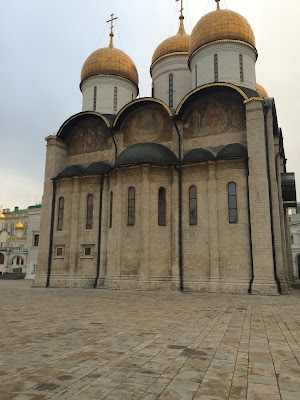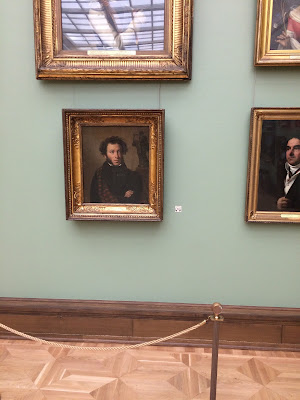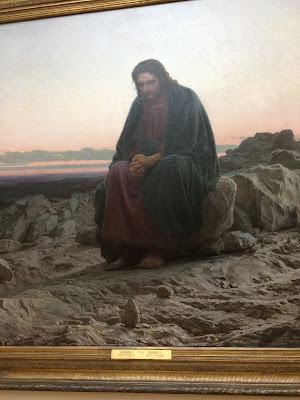A couple of weeks ago at a church meeting, a man in our
congregation gave a small sermon. He started out by talking about a documentary
he had watched about a group of ex-gang members in inner-city Chicago called
the “Interrupters.” These people have broken the cycle of violence in their own
lives and are trying to help others break that cycle. They show them that there
is a different way to resolve conflicts; there is more to life than revenge and
killing.*
The man then related the work of the “Interrupters” to God’s
work—God also calls us to change our lives, and to break those cycles of pride,
violence, apathy, bitterness, etc. He tells us that there is more to life than
what we see, and that we “don’t have to live like this.” We can change. We can improve.
The man’s mini sermon was impromptu; he didn’t know he was
going to speak that day, but his words really touched me and I have thought a
lot about them. We speak of worshipping the God of deliverance, of worshipping
the God who weeps. But what does it mean if we worship the God who interrupts?
And what does that mean at Christmas time?
Especially because the Christmas story—indeed, Christ’s
story—is a series of interruptions from the very beginning.
The story starts in medias
res, as many stories do, and we learn that in a certain city called
Nazareth, there is a certain “virgin espoused to a man whose name was Joseph,
of the house of David; and the virgin’s name was Mary.” (Luke 1:27)
Mary is simply going about her life. She is a good girl,
just getting ready for her upcoming wedding. Excited, no doubt, but just living
life.
But then comes the interruption of her life.
“And [an] angel came in unto her, and said, Hail, thou that
art highly favoured, the Lord is with thee: blessed art thou among women.
And when she saw him, she was troubled at his saying, and
cast in her mind what manner of salutation this should be.
And the angel said unto her, Fear not, Mary: for thou hast
found favour with God.
And, behold, thou shalt conceive in thy womb, and bring
forth a son, and shalt call his name Jesus.” (
Blessed Art Thou Among Women, Walter Rane
What a disruption! Here is Mary, a young
woman engaged to a man she cares deeply about. Of course she has thought about
their life together—with their own home, garden, and little children to teach
and love. But this—how could this be? What was the angel saying? What kind of
message was this? What kind of God would ask a normal, upstanding country girl
to agree to something so strange, something that could ruin her reputation forever?
To Mary, Gabriel’s message was initially troubling. She didn’t
understand how or why the Lord chose her to be the mother of the Son of God.
However, she gave her consent. She agreed to be part of this miracle, even
though she could not possibly comprehend it . . . even though it interrupted
her life in a very drastic way, and even though it threatened her relationship
with Joseph.
According to Thy Word, Elspeth Young
Because this was not just an interruption in Mary’s life. It
disrupted Joseph’s life, too. He agonized over it. This lovely couple—who I
think were in love with each other and hopeful about a future together—had their
ordinary lives interrupted quite abruptly by a baby—a baby Joseph knew was not
his; a baby Mary did not completely understand, yet unconditionally loved.
I find it striking that when Joseph and Mary were confused
and frightened by this news that an angel—a heavenly interrupter—told them each
to “fear not.”
To Joseph: “Fear not to take unto thee Mary thy wife: for
that which is conceived in her is of the Holy Ghost. And she shall bring forth a son, and thou shalt call his
name Jesus; for he shall save his people from their sins.”(Matthew 1:20-21)
And to Mary: “Fear not, Mary: for thou hast found favour
with God. [. . .] The Holy Ghost shall come upon thee, and the power of the
Highest shall overshadow thee; therefore also that holy thing which shall be
born of thee shall be called the Son of God. [. . .] For with God nothing shall
be impossible.”(
Fear not. Yes,
this interruption is alarming. It is different than anything you’ve ever known.
It will change your life—and the world—as you know it. But fear not. Choose
faith. Choose action. Choose to believe.
And that is what Mary and Joseph chose to do. They embraced
this holy interruption with humility and dignity. They changed their lives
completely.
The Road to Bethlehem, Jospeh Brickey
Christ’s birth, like all births, was an interruption.
Although you can prepare for a child, and even though you expect and plan and
wait, ultimately, a birth—any birth—comes at an unexpected and inopportune
time. Christ’s birth was no different.
Nativity, Brian Kershisnik
Now we plan for Christmas. We buy gifts. Make dinners. Sing
carols. But no one was prepared for the first Christmas.
How were Mary and Joseph to plan for an inconvenient census
trip to Bethlehem—with Mary’s due date drawing closer and closer?
How was the couple to prepare for the fact that there was no
room at the inn?
And how could the shepherds have anticipated a glorious
announcement of their long-awaited Messiah that first Christmas night?
Just as Mary and Joseph were unprepared for Christ’s interruption
in their lives, the shepherds were unprepared for the heavenly interrupters—those
angelic messengers—announcing the birth of a Savior. Their Savior:
“And there were in the same country shepherds abiding in the
field, keeping watch over their flock by night.
And, lo, the angel of the Lord came upon them, and the
glory of the Lord shone round about them: and they were sore afraid.
And the angel said unto them, Fear not: for, behold, I
bring you good tidings of great joy, which shall be to all people.
For unto you is born this day in the city of David a
Saviour, which is Christ the Lord.
And this shall be a sign unto you; Ye shall find the babe
wrapped in swaddling clothes, lying in a manger.
And suddenly there was with the angel a multitude of the
heavenly host praising God, and saying,
Glory to God in the highest, and on earth peace, good will
toward men.”(
Good Tidings of Great Joy, Walter Rane
The shepherds were just going about their own business,
doing their job.
The normal.
The usual.
The ordinary.
And then. Then the angels came in brilliant glory—setting the
Judean night sky and hillside ablaze with light, announcing that there was
more.
“You don’t have to live like this.”
Like Mary and Joseph, the shepherds heeded the grandest
interruption of their lives. They set aside their fear and uncertainty and
decided to act. They went into Bethlehem and found the Child. They found peace
and new direction. They found that there is
a Savior.
A Prince of Peace.
Wonderful.
Counsellor.
The Mighty God.
For unto you is
born this day, in the city of David, a Savior, which is Christ the Lord.
Ye who are lonely, laden, forlorn—oh friendless, fallen
world . . . to you a Savior is born.**
Christ interrupts our lives. Sometimes, like Saul on the
road to Damascus or Alma the Younger set on destroying the Church of God, those
interruptions are dramatic. More often, however, He stands at the door and
knocks, interrupting our supper or favorite television programs.
He interrupts us, telling us that we don’t have to live like
we currently do. We don’t have to settle for the mundane. The dark. The lonely.
The despair. The anger, violence, and evil of this world do not have to be a
part of us.
He is the Inconvenient Messiah.
The One who asks us to leave the comfort of the hillside and
seek Him.
The One who tells us to forsake our nets for His work.
The One who tells us to put mud on our eyes so we can see.
The One who commands us to give up all we possess and follow
Him.
The One who asks us to believe, even if we do not completely understand.
The One who entreats us to love our neighbors as ourselves
and do unto others as we would have them do unto us.
The One who has “hard sayings,” who insists that He has come
not to bring peace, but a sword, and to cut off those things which keep us from
Him.
The One who commands a higher law; a more excellent way.
Christ is the Grand Interrupter. He interrupts the ordinary—our
ordinary. And the interruptions jolt us. His way is not easy. It never has
been. He asks us to not only believe that there is a different way to live, but
He asks us to change. To root out our desires for pride, revenge, and
complacency. To break the cycle. He sees our potential. He believes in our
goodness and asks us to believe in His.
This Christmas, remember the interruptions.
Remember His
entrance into the world—perhaps only noticed by only a handful, but oh, how
that glorious interruption meant the world for those who received Him.
Remember His interruptions into the lives of ordinary fishermen
at Galilee, publicans, sinners, and Pharisees.
Remember how He has interrupted your life—whether in grand
or simple ways.
And remember that He will continue to interrupt.
“Come,” He says. “You don’t have to live like this. There is
something more. You can be something more.”
Christ Healing at the Pool of Bethesda, Carl Bloch
The choice of how to respond to Him is ours. It has been and
always will be.
* Here
is a link to The Interrupters. It is
an incredibly powerful documentary and well worth your time if you haven't seen it before. Even if you have seen it before.






















































